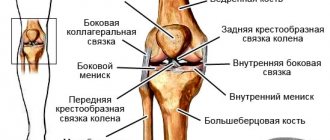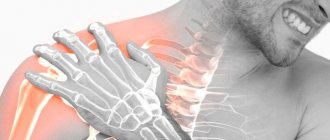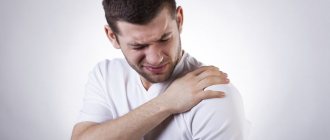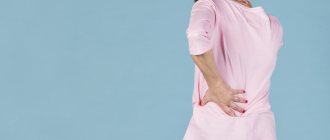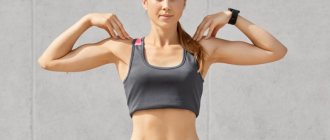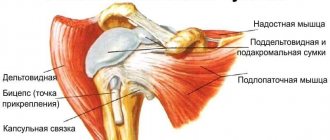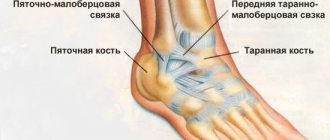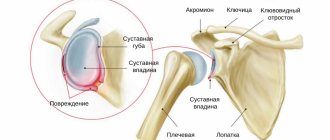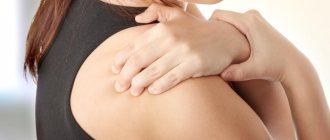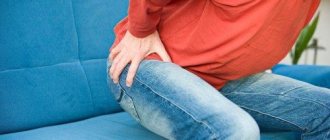The shoulder joint has a complex structure. This structure connects three bones together, holding them together with the help of a whole complex of ligaments.
Due to the high load on the ligaments of the shoulder joint, this area is especially susceptible to injury and damage.
Ligaments here are often stretched and torn. For a person, this is accompanied by severe pain and limited mobility.
Timely and competent treatment of shoulder ligaments helps restore activity and get rid of pain.
First aid for shoulder ligaments
Ligament damage is most often caused by injuries, falls, and heavy physical activity. Less commonly, tissue rupture is caused by a degenerative process.
This condition manifests itself as a sharp acute pain in the shoulder, which becomes more intense with any movement of the arm. In case of severe damage, redness and swelling of the tissue may appear on the surface of the skin.
First aid in this case consists of the following actions:
- Ensure limb rest. It is advisable for the person to lie on his side with his arm parallel to his body. This way you can completely immobilize the shoulder joint.
- Apply cold to the damaged area. Cooling the tissue in the injury area will quickly relieve pain and reduce swelling. The optimal solution is to apply a heating pad filled with ice or cold water to the site of rupture or sprain of ligamentous structures.
- Secure the joint. Sometimes it is advisable to secure the damaged joint with a thick elastic bandage.
- Pain relief. If the patient experiences unbearable acute pain, his condition should be relieved by taking an NSAID, an analgesic, or using a local anesthetic ointment.
The basic principles of first aid for sprains boil down to fixation and rest of the affected area.
Diagnosis of diseases
Determining whether ligaments are sprained or torn is not always easy. First, the doctor examines the shoulder.
When a rupture occurs, the joint area usually becomes very swollen, which is indicated by a change in its contour. Any movement causes severe pain.
To make an accurate diagnosis, it is necessary to conduct the following instrumental studies:
- X-ray examination;
- arthrography (x-ray with contrast);
- ultrasound examination (ultrasonography).
If this diagnostic complex is not enough, an additional MRI may be prescribed.
Treatment of shoulder ligaments
To quickly cope with pain and restore limb mobility, it is necessary to begin treatment for a sprained or torn ligament as soon as possible.
There are several methods of therapy. The maximum effect is achieved when they are combined.
Conservative therapy
Drug treatment for sprains and ligament tears comes down to taking non-steroidal anti-inflammatory drugs (NSAIDs). These drugs help reduce swelling, relieve inflammation and relieve pain.
The most commonly used medications are:
- diclofenac sodium;
- indomethacin;
- ibuprofen;
- ketanov;
- meloxicam.
To speed up the recovery of the ligamentous apparatus, collagen preparations, chondroprotectors, calcium and vitamin D complexes can be additionally prescribed.
Ointments
To avoid side effects and systemic effects on the body of drugs for internal use, doctors most often prescribe the use of ointments.
When choosing an ointment, it is important to consider its ability to penetrate the skin and reach the tissues of the articular apparatus.
Ointments of the following groups are effective:
- Ointments with NSAIDs. These compositions act by the same mechanism as NSAIDs for internal use. The ointments Voltaren, Diclofenac, Ketoprofen are most effective against pain and inflammation.
- Ointments with steroid hormones. The content of steroids in the ointment provides a pronounced anti-inflammatory effect. This speeds up tissue repair and relieves pain. The most commonly used ointments in this group are those based on hydrocortisone and prednisolone.
- Cooling ointments. Using ointments based on Menthol and Camphor, you can achieve a slight analgesic effect, as well as activation of blood circulation in the area of injury.
Before using any topical formulation, it is advisable to consult a doctor.
Gymnastics for shoulder sprains
Gymnastics for sprained shoulder joints should be performed with caution, and only after the acute pain syndrome has been eliminated.
It is absolutely forbidden to do exercises through pain. This can only make the situation worse. Most of the exercises are performed while sitting on a chair or standing against a wall.
Effective exercises in the process of restoring the shoulder joint include:
- forearm rotation;
- raising and lowering your shoulders with your arms down;
- swinging a relaxed arm;
- circular movements of the shoulder blades;
- a set of exercises with a stick;
- imitation rowing;
- imitation of hammer throwing.
Classic set of exercises for arthrosis
Before you start doing gymnastics, you should consult your doctor. He will choose a complex taking into account the particular course of the disease, the severity of the condition, and the stage of the disease.
Gymnastics for knee joints with arthrosis
A set of exercises for gonarthrosis is performed for the purpose of prevention and during remission of the disease. Classes begin with a light warm-up and simple exercises. One of the main components of exercise should be stretching with a small amplitude.
Exercises for knee joints with arthrosis
At the beginning of the course, perform a minimum of exercises, gradually increasing their number. It is imperative to monitor your well-being: an increase in heart rate, dizziness, and acute pain may indicate excessive stress and the need to stop exercising.
Best exercises
- Lying on your back, one leg is bent at the knee joint and pulled up to the thigh without lifting the foot. Then she bends at the hip joint, wraps her arm around her and pulls herself towards her stomach. Hold this position for 10 seconds. After this, the foot is lowered to the floor, the leg is slowly straightened. The movement is repeated 10 to 20 times. In the starting position, the legs are bent at the knees and raised. Movements are performed that simulate riding a bicycle.
- Lying on your stomach, bend your leg at the knee joint, without lifting your thigh off the floor. We touch the buttock with the heel. Repeat from 20 to 40 times.
- Sitting on the floor, stretch your legs slightly apart. Try to reach your feet with your hands without bending your knees. Stay in the bent position for 5-10 seconds. The movement is repeated 5 to 10 times.
Prohibited exercises
With gonarthrosis, playing and strength sports are prohibited. When performing exercises, jerking and sudden lunges are not allowed, and deep squats cannot be performed. For patients with degenerative processes in the knee joint, it is unacceptable to sharply increase the load and duration of exercise, or perform gymnastics, overcoming pain.
Gymnastics for the hip joint with arthrosis
In case of coxarthrosis of I or II degree, preference is given to exercises in a lying position or sitting on the floor, in case of III degree - sitting on a chair or lying down. At the beginning of the complex, light warm-up exercises are performed, at the end of the exercises, the arms are raised, a deep breath is taken, and the arms are lowered and exhaled. In this way, smooth breathing is restored.
Exercises for the hip joint with arthrosis
Best exercises
- Lie on your stomach, place your arms along your body. Raise your straightened legs smoothly and slowly and hold them in this position for 10 seconds. Perform 5 repetitions. In the future, the number of movements and duration of the fixed position can be increased to 20 seconds.
- Lying on your side, bend your lower leg at the knee, straighten your upper leg and lift it up. Hold for 10 seconds. Turn over to the other side and repeat the movements.
- Sitting on the floor, try to reach your toes with your hands, smoothly tilting your back, without jerking or sudden movements.
- Sitting on a chair, spread your legs slightly, lean forward slightly and sway from side to side 15 times.
Each exercise is performed 5 times. Over time, the number increases to 10.
Gymnastics in the “on the stomach” position is performed once in a complex; other exercises for arthrosis are recommended to be alternated and performed in 4 approaches. The duration of exercise therapy is 20 minutes at the initial stage, which can gradually be increased to 40 minutes.
Prohibited exercises
- squat;
- circular movements of the legs;
- active flexion and extension of the back and legs.
Crunching in joints - when to worry
Intra-articular injections of hyaluronic acid
If you have coxarthrosis, long walks are not recommended.
Gymnastics for shoulder and elbow joints with arthrosis
Exercises should be done carefully, smoothly and slowly, avoiding sudden movements and pain.
Exercises for shoulder and elbow joints with arthrosis
Best exercises
- Slowly raise your right arm up and bend it at the elbow joint. Place your palm on your healthy shoulder and support your elbow with your left hand. The palm should slide over the shoulder. Count to eight and move your hand further without pain. Relax your hand and repeat the exercise 4 times.
- Carefully place your right hand behind your left shoulder, and your left hand behind your right. Try to reach your spine with your fingers. Keep your elbows as high as possible. After 8 seconds, return to the original position. Repeat the exercise eight times during class.
- Turn the back of the chair towards you, maintaining a distance of 40 cm. Bend over so that your arms remain straight (tilt angle 90º). For 8 seconds, stretch your shoulder joints down. Return to the starting position. Repeat the exercise eight times.
- Place your sore hand on the table, place the palm of the opposite hand on the shoulder joint. Raise your shoulder up and create resistance with your hand. Relax your shoulders and use your palm to perform gentle pressing and rocking movements for 8 seconds; after 5 seconds of relaxation and rest, repeat the movements four times.
- Place the palms of your left and right hands together in a handshake behind your back. Stretch your elbows, trying to connect them. After 8 seconds, return to the original position. Repeat the movement eight times during the session.
Prohibited exercises
Exercises with any arthrosis with sudden raising and swinging of the arms, vigorous bending and straightening of the elbows are prohibited. Gymnastics is prohibited for fractures and other injuries of the shoulder, including dislocations and sprains, arthritis, colds of viral and microbial etiology, for three months after surgery on the breast, neck, shoulder. After such operations, you should definitely consult a surgeon.
Help from traditional medicine
Traditional medicine offers several effective recipes to relieve pain and inflammation in the shoulder. Most often, homemade ointments are used for this purpose:
- An ointment based on pork fat with the addition of 3-5 grams of propolis, when used regularly, fights the inflammatory process.
- A mixture of mustard and honey provides a moderate irritant effect and stimulates blood flow to the affected area.
- Vaseline-based ointments are prepared by adding the herbs St. John's wort, sweet clover, and yarrow. Such compositions reduce pain.
Shoulder Anatomy: Passive Systems
The shoulder is more than a single joint. The complete kinematic chain runs “from nose to toes” and it is impossible to list all the relationships in this case. However, when we look at the shoulder we will include some of its broad connections to other parts of the body.
The human movement system includes the actions of the joint, nervous and muscular systems (Clark & Lucett, 2010). In what follows, we will call the articular system, including bones, joints and ligaments, the “passive” system, and the muscular system the “active” system.
The passive system provides fulcrum, support, and leverage for the muscular system. The main bones of the shoulder girdle include the humerus, scapula and clavicle. The shoulder girdle complex interacts with the rib cage, thoracic and cervical spine. The lumbar region and pelvis can also be included due to muscular and fascial connections. When the passive system is asymmetrical, it can result in shortening of the active system, causing decreased performance, reduced endurance, and increased risk of injury (Travell & Simons, 1983).
The joints most closely associated with the work of the shoulder are the humerus (HL), acromioclavicular (AC), sternoclavicular (SC) and scapulothoracic (SL) joints. An in-depth description of these joints is beyond the scope of this article, but personal trainers should thoroughly research these joints before creating programs for clients.
The LH joint is classified as a false joint due to the lack of direct interaction between the bones. The scapula simply glides across the surface of the chest, however, the significance of these movements to shoulder function warrants their inclusion in the review. The intercostal and costovertebral joints associated with the thoracic spine can influence local and general musculature (Epstein et al. 1993). Despite their small size, these joints are an integral part of the chest.
When the bones are in perfect alignment, a full range of motion is possible at the joints. For example, flexion, abduction, adduction, internal and external rotation, and circumduction will be possible in the shoulder joint. This joint is extremely mobile and can provide a large range of motion. High mobility is accompanied by a low level of stability. The scapulothoracic muscles help slow down the movement when throwing, acting as a kind of anchor: the chest in relation to the scapula, and the scapula in relation to the humerus through the glenoid fossa.
The scapula is a kind of platform for the humerus. If the scapula is in the correct position, the humerus follows (Sahrmann, 2001). The scapula is capable of ascending, descending, moving forward and backward (protraction and retraction), and rotating outward and inward. Also sometimes referred to as forward and backward deviation of the scapula. The acromion process of the scapula is connected to the clavicle by the AC joint.
The acromion is the wide, ridge-like end of the bone and can have three shapes. Type 1 - flat, type 2 - curved, type 3 - hooked - which determines the amount of free space for the rotator cuff, biceps tendon and joint capsule. Anomalies of the acromion are congenital and no corrective exercises will create more free space. Type 3 uncinate acromion is associated with the highest incidence of rotator cuff injuries (62%) and impingement (30%) (Epstein et al. 1993).
The correct position and functionality of the HA and AC joints can be difficult to assess. Maintaining their delicate interaction promotes shoulder health and function. If you suspect their function is impaired, contact a licensed physician for evaluation (Lee, 2003).
Normalizing the position and function of the thoracic region is often forgotten. In people who move extremely little during the day, the thoracic spine is often excessively flexed and extension and rotation are limited. A posture that increases thoracic kyphosis reduces the effectiveness of the scapular stabilizers and rotator cuff muscles (Clark & Lucett, 2010). Violation of the position of the shoulder blades is a sufficient basis for analyzing and assessing the mobility of the thoracic region.
The structure of the ligamentous apparatus of the shoulder girdle is of particular interest. Ligaments are not only flat, straight formations that provide static support to joints. They can twist like a rope.
Closer to the limit of the range of motion, ligament tension and support from the joint capsule increases to prevent damage. Ligaments also contribute to proprioception, providing the nervous system with valuable feedback about joint position and tension (Osar, 2012).
Cartilage provides a smooth surface for joint interactions. Disturbances in the kinematics of joints and bones wear down this tissue over time. The destruction of cartilage is immediately followed by pain and inflammation.
The subacromial, subdeltoid and other bursae reduce friction in the shoulder joint. The subacromial bursa most often becomes inflamed after repeated impingement between the humerus and acromion.
Repeated stress destroys active systems faster than passive ones. If a client is experiencing pain as a result of a passive system injury, the movement disorder is likely to have appeared somewhat earlier. The functions of the active system are much more easily disrupted. Tendenitis will immediately appear with poor posture and repeated incorrect movements.
Kinesitherapy in the treatment of shoulder ligaments
Kinesitherapy is a complex of well-chosen physical activity that promotes the restoration of damaged ligaments and other joint structures.
Exercises are selected individually for each patient. This helps improve blood circulation in the damaged area, activate metabolic processes, and strengthen ligaments and muscles.
You can undergo kinesitherapy under the supervision of experienced specialists in our Centers located in Zelenograd, Tver, Dubna and Klin. Treatment of the shoulder joint in our Centers guarantees:
- rapid therapeutic effect;
- restoration of joint mobility;
- elimination of pain syndrome;
- safety of treatment;
- attentive attitude of specialists.
Turning to professionals will help you quickly cope with the unpleasant consequences of rupture, sprain and inflammation of the shoulder ligaments.
MESSAGE FROM THE CHIEF DOCTOR:
Often, when examining a patient, doctors pay attention only to the bones, ligaments, and joints. At the same time, nothing is said about muscles
, the function of contraction of which plays a significant role in human life. Weakened muscles lead to thinning and deformed bones.
Unfortunately, common methods of therapy only aggravate the situation, leading to even more severe pain, muscle atrophy and a deterioration in the quality of life of patients.
Effective treatment is impossible to imagine without muscle restoration. Unique kinesitherapy technique
consists in a therapeutic effect, which implies, first of all, muscle activity during the methodical execution of a set of exercises on special simulators.
All exercises are performed by patients sitting or lying down, so there is no excessive stress on the joints and circulatory system, and our instructors-methodologists correct the technique of movements
and monitor the correct execution of actions.
Remember that diseases of the spine and joints are not a death sentence; if the patient wishes and the right approach to treatment, everything can be corrected!
Isometric exercises as an alternative to treating joints and ligaments
Let's figure out what isometric exercises are. This is one of the ways muscles contract without changing their length. In such exercises, the joint does not move, but the tendons are strengthened. joint pain
- this is a sign of the development of the disease, so it is possible that the doctor will prescribe various types of isometrics, both passive and active exercises that strengthen the rotator cuff. During isometric movements, the muscular system does not contract, but becomes toned. Thus, muscle growth is not observed, but they are strengthened and elasticity appears.
Types of exercises and techniques for performing them
treatment of joint bruises
, sprains and other problems will happen faster if you perform certain exercises, not forgetting some rules:
- Stretching before training;
- Proper breathing, it should be uniform;
- Increasing the strength of the exercise during training;
- Strict adherence to technology.
There are two well-known systems: the Samson complex and the Bruce Lee system. Isometrics from Bruce Lee is suitable for everyone, especially beginners. It includes basic exercises - lunges and squats, scissors, push-ups from the wall (floor).
Bruce Lee's Rules:
- The training is done in the morning.
- Be sure to ventilate the room, because... deep breathing accompanies every isometric movement.
- Contrast shower after gymnastics.
The main advantages and benefits of isometric exercises:
- This kind of physiotherapy significantly reduces the time of training (especially if you are a busy person), since most exercises can be completed in a couple of minutes;
- Rehabilitation - performing isometric exercises improves flexibility and muscles after surgery. It is believed that such exercises minimize the risk of arthritis and the development of osteoporosis;
- 3. Correction of posture. Research shows that the isometric system aligns the body and spinal column, which helps resolve spinal problems;
- Body harmony. This type of training improves body control and teaches proper breathing;
- 5.Savings. Performing isometric gymnastics does not require any special equipment or expenditure of funds - the work is done directly on the body without sports equipment;
- Age is not a limitation. You can perform isometric gymnastics at any age, but be sure to prescribe it from a doctor.
Isometric exercises for the shoulder.
As a rule, there are a huge number of different isometric exercises, but below we will look at an easy workout for the shoulder.
1. Shoulder flexion
Take a standing position facing the wall and bend your elbow. Make a fist and gently press into the wall. Next, hold your hand for 5 seconds and then relax. The minimum number of repetitions is 15 times, but you need to be careful if you are a beginner.
2. Shoulder abduction
You need to stand with your side to the wall, your arm bent at the elbow and pressing into the wall. Further, the task becomes more complicated - you need to push the wall with maximum force, hold the compression for about 10 seconds, release, and then repeat two more times. This will develop the shoulder for activities such as putting on a shirt.
3. Shoulder internal rotation.
Standing in front of a wall or door frame, place your feet hip-width apart and bend your elbows slightly. Push the wall with your right forearm and engage your core muscles. Press down on the door frame as hard as you can. Hold the contraction for up to 12 seconds and repeat anywhere three to five times. You can switch hands and perform internal rotation again. This uses the same muscles that are activated when you reach behind your back. For example, to tuck in clothes.
4. Isometric shoulder external rotation.
There are several external rotation exercises. One of the best is the flasher. She encourages the use of resistance bands. You simply pull both ends of the band at the same time to challenge the external rotation muscles. The exercise is aimed at developing movement while washing your hair.
5. Isometric shoulder grip with a towel.
Form a straight line with a long towel and step on one end of the towel with your left foot. Grab the other end of the towel with your left hand. With your legs slightly bent, raise your left arm up until it is parallel to the ground. Hold until you feel pressure (usually about 30 seconds), then switch sides and repeat the same action on your right hand. You need to do up to 10 repetitions.
How often should you do isometrics?
Efficiency is achieved only if you engage in physical education systematically (constantly).
If you have never done isometric exercise, it is best to start with 25 percent effort and work your way up to 100 percent effort. You will find that the more movements you do, the easier the technique and tasks become.
The longer you do this physical activity, the more your muscles get used to the load and become toned.
The isometric gymnastics complex consists of a larger number of exercises; the simplest examples are given here. The best effect occurs when the exercises are repeated every other day. Depending on how ready the body is for this type of activity, record their total time, which should be at least 15, but not more than 45 minutes. It is recommended to repeat physical activity two to three times a week. Before performing gymnastics, you should consult your doctor. Be attentive to your body! Author: K.M.N., Academician of the Russian Academy of Medical Sciences M.A. Bobyr


